 Happy first day of Ginvent! Here we are for my fourth year and kicking off the festivities with Conniption Navy Strength gin. Hailing from the Durham Distillery, this gin isn’t from the Durham of Cathedral fame, instead they are based in Durham, North Carolina. We’ll take a short detour here to talk about American gins as they have some different rules over the sea. Here in the UK, to be gin the flavour must be “predominantly” juniper with a minimum ABV of 37.5%. In the USA, gins have to be “characteristically” juniper and a minimum of 40% ABV. This means their gins have a different feel as the juniper is less obvious (at least in the American gins I’ve tried previously) which allows them to play with their flavour profile a bit more. Now we have that out the way, the distillery uses a two step process to create their gins. First they perform a traditional distillation in a copper pot, then they move on to a more modern vacuum distillation for their more delicate botanicals. Their original gin uses cucumber and honeysuckle to create a fresh and floral finish, and usually when a brand creates a navy strength gin they tend to just amp up their recipe. Here, they share just three botanicals but add sweet citrus and fig and raises the ABV to 57%. They have won a number of awards, most recently winning the Best American Navy Strength gin at the 2019 World Gin Awards and before that a double gold (pretty impressive) at the 2017 San Francisco World Spirits Competition. So, how does it taste?
Happy first day of Ginvent! Here we are for my fourth year and kicking off the festivities with Conniption Navy Strength gin. Hailing from the Durham Distillery, this gin isn’t from the Durham of Cathedral fame, instead they are based in Durham, North Carolina. We’ll take a short detour here to talk about American gins as they have some different rules over the sea. Here in the UK, to be gin the flavour must be “predominantly” juniper with a minimum ABV of 37.5%. In the USA, gins have to be “characteristically” juniper and a minimum of 40% ABV. This means their gins have a different feel as the juniper is less obvious (at least in the American gins I’ve tried previously) which allows them to play with their flavour profile a bit more. Now we have that out the way, the distillery uses a two step process to create their gins. First they perform a traditional distillation in a copper pot, then they move on to a more modern vacuum distillation for their more delicate botanicals. Their original gin uses cucumber and honeysuckle to create a fresh and floral finish, and usually when a brand creates a navy strength gin they tend to just amp up their recipe. Here, they share just three botanicals but add sweet citrus and fig and raises the ABV to 57%. They have won a number of awards, most recently winning the Best American Navy Strength gin at the 2019 World Gin Awards and before that a double gold (pretty impressive) at the 2017 San Francisco World Spirits Competition. So, how does it taste?
spirits
Never Never Juniper Freak gin
Note: This post contains affiliate links marked as [Ad], if you click on this and buy a bottle of gin then I will receive a small commission.
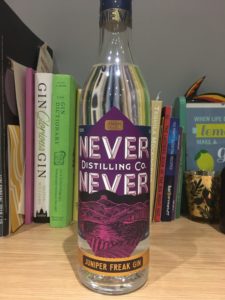
Back in June, I visited Junipalooza and finally got a chance to meet the Never Never Distilling Co. Based in Adelaide, Australia, they say they embrace the Australian spirit of adventure (is that a thing?) and produce some of the most juniper forward gins on the market. This inspires the name Never Never, which TBH just makes me think about Neverland, which is kinda of the point – they celebrate those that dare to be different and seek more from life. Started by friends George (the science whizz), Sean (sales and marketing expert), and Tim (head distiller), the three came together and are currently based at the home of Big Shed Brewing, but long for their own space in the outback. They currently make three key gins, their ‘normal’ gin is Triple Juniper (which funnily enough is juniper heavy), their Southern Strength (52% ABV) and then today’s gin, the Juniper Freak which is an ode to the juniper berry. This gin sits at 58% which gives it a punch and helps to amp up the oily juniper – the description for this might be my favourite ever: “It’s a seriously big gin, but hey, we’re not here to fuck spiders”. I don’t know if that’s an Aussie saying but I love it. The Juniper Freak won Australia’s Best Navy gin at the 2019 World Gin Awards, so how does it taste?
Lakes gin
Note: The team at The Lakes Distillery sent me a sample of their new recipe to try, but as always I’ll let you know what I really think.
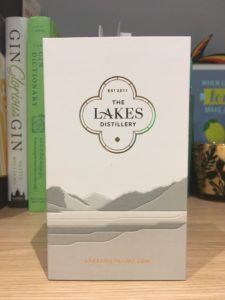 Back in February 2017, I was sent a sample of Lakes gin to try. Then, on my 30th birthday (10 October 2019 FYI) I received an email from the team saying they had reworked the recipe and had a beautiful rebrand to boot. After launching their single malt whisky, they have looked back at their gin and worked on it to ensure it stands the test of time. They’ve adopted a ‘less is more’ approach and now take a British wheat spirit as their base, and infuse in this their new range of botanicals; juniper and coriander are bound with angelica, orris root, cassia bark and liquorice before finishing with orange and lemon peel. They steep these in the spirit overnight to release the essential oils before distilling their gin in a copper pot still. Their rebrand reminds me of Mermaid gin, which was a great product in a fairly bland bottle; they get a jazzy new bottle and suddenly everyone takes notice. The new Lakes gin bottle features a new, leaner shape, an engraved glass bottle and a new label. The new recipe has also ramped up the ABV from 43.7% to 46%, hopefully ensuring the juniper is still front and centre. So, how does it compare?
Back in February 2017, I was sent a sample of Lakes gin to try. Then, on my 30th birthday (10 October 2019 FYI) I received an email from the team saying they had reworked the recipe and had a beautiful rebrand to boot. After launching their single malt whisky, they have looked back at their gin and worked on it to ensure it stands the test of time. They’ve adopted a ‘less is more’ approach and now take a British wheat spirit as their base, and infuse in this their new range of botanicals; juniper and coriander are bound with angelica, orris root, cassia bark and liquorice before finishing with orange and lemon peel. They steep these in the spirit overnight to release the essential oils before distilling their gin in a copper pot still. Their rebrand reminds me of Mermaid gin, which was a great product in a fairly bland bottle; they get a jazzy new bottle and suddenly everyone takes notice. The new Lakes gin bottle features a new, leaner shape, an engraved glass bottle and a new label. The new recipe has also ramped up the ABV from 43.7% to 46%, hopefully ensuring the juniper is still front and centre. So, how does it compare?
Darnley’s Smoke and Zest gin
Note: Darnley’s sent me a sample of their new gin to try, but as always, I’ll let you know what I really think.
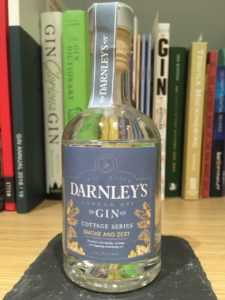 For today’s tasting we are travelling back up north to Scotland, specifically the east coast of Fife to a town called Kingsbarn to try the newest in the Cottage Series released by Darnley’s. At the 13th-century Wemyss Castle, Mary Queen of Scots met her future husband Lord Darnley – an occasion that later inspired the Wemyss family (who already run an established whisky distillery) to renovate a cottage and try their hand at gin distilling. They plumped for a London Dry gin style, first steeping their botanicals in a four times distilled neutral grain spirit, before distilling it in their 300l pot still for a fifth time. Their core range of gins started with their Original gin, inspired by the wild elderflower growing on their estate, which creates a light, floral gin. They then went on to make their Spiced gin which brings flavours of pine needles, peppercorns, cloves, rosemary and cardamom. They then created a Navy Strength edition of their Spiced gin, bringing it up to 57% and adding in more juniper to allow the flavours to shine even at this higher ABV. Because having three spirits isn’t enough, Darnley’s are now creating limited edition gins, known as the Cottage Series. These releases are inspired by the botanicals growing on their estate and beyond. The first, launched in July 2018, featured sloe berries, rosehip and elderberry and was originally named the Very Berry edition. Today we try their second release, the Smoke and Zest. For this, their distiller Scott Gowans has taken the home grown barley that is used in their single malt whisky and smoked it in his family’s smoker with pine wood chips. They balance the smoke out with rowanberry and coriander (grown at the distillery) for a touch of sweetness and Turkish orange peel for that tang. The inspiration for this really comes from rowanberries, also known as Mountain Ash and it was this name that inspired Scott to look for something smokey to add to the citrus. The idea to smoke the barley over pine chips came from the production of Lapsang Souchong tea, to create what they call an unusual gin with juniper at its heart. So, how does it taste?
For today’s tasting we are travelling back up north to Scotland, specifically the east coast of Fife to a town called Kingsbarn to try the newest in the Cottage Series released by Darnley’s. At the 13th-century Wemyss Castle, Mary Queen of Scots met her future husband Lord Darnley – an occasion that later inspired the Wemyss family (who already run an established whisky distillery) to renovate a cottage and try their hand at gin distilling. They plumped for a London Dry gin style, first steeping their botanicals in a four times distilled neutral grain spirit, before distilling it in their 300l pot still for a fifth time. Their core range of gins started with their Original gin, inspired by the wild elderflower growing on their estate, which creates a light, floral gin. They then went on to make their Spiced gin which brings flavours of pine needles, peppercorns, cloves, rosemary and cardamom. They then created a Navy Strength edition of their Spiced gin, bringing it up to 57% and adding in more juniper to allow the flavours to shine even at this higher ABV. Because having three spirits isn’t enough, Darnley’s are now creating limited edition gins, known as the Cottage Series. These releases are inspired by the botanicals growing on their estate and beyond. The first, launched in July 2018, featured sloe berries, rosehip and elderberry and was originally named the Very Berry edition. Today we try their second release, the Smoke and Zest. For this, their distiller Scott Gowans has taken the home grown barley that is used in their single malt whisky and smoked it in his family’s smoker with pine wood chips. They balance the smoke out with rowanberry and coriander (grown at the distillery) for a touch of sweetness and Turkish orange peel for that tang. The inspiration for this really comes from rowanberries, also known as Mountain Ash and it was this name that inspired Scott to look for something smokey to add to the citrus. The idea to smoke the barley over pine chips came from the production of Lapsang Souchong tea, to create what they call an unusual gin with juniper at its heart. So, how does it taste?
Warner Edwards Farmed & Foraged Gin
Note: I pester Emile and Olivier over at Gin Foundry a lot and at Junipalooza they kindly handed me an apple mint plant and told me to be patient. Two months later, they have now gifted me a little bottle of gin to go with the garnish, but as always, I’ll let you know what I think.
 Even newbies to the gin game should recognise Warner Edwards, if not, they are basically the people that made the first rhubarb gin. They also make lots of other yummy gins, I’m particularly in love with their Honeybee gin with lemon, honey and a splash of hot water whenever I have a cold. They are very big on sustainability and grow many of their own botanicals (including the honey from their own bees) from their farm. They use water from their spring and are believers in good things coming to those that wait; no over harvesting here. Instead they try to put more back into the soil than they take. They’ve been besties with the Gin Foundry crew for a while, being one of the few brands that have been involved with Junipalooza from the beginning, and they have now teamed up for a limited edition gin. They gave the team at Warner Edwards a challenge – only use botanicals within a three mile bee flight of the distillery. They wanted to look at not just the botanicals that work together, but how the environment can shape a flavour profile and working with the land around you from planting through to harvesting.
Even newbies to the gin game should recognise Warner Edwards, if not, they are basically the people that made the first rhubarb gin. They also make lots of other yummy gins, I’m particularly in love with their Honeybee gin with lemon, honey and a splash of hot water whenever I have a cold. They are very big on sustainability and grow many of their own botanicals (including the honey from their own bees) from their farm. They use water from their spring and are believers in good things coming to those that wait; no over harvesting here. Instead they try to put more back into the soil than they take. They’ve been besties with the Gin Foundry crew for a while, being one of the few brands that have been involved with Junipalooza from the beginning, and they have now teamed up for a limited edition gin. They gave the team at Warner Edwards a challenge – only use botanicals within a three mile bee flight of the distillery. They wanted to look at not just the botanicals that work together, but how the environment can shape a flavour profile and working with the land around you from planting through to harvesting.
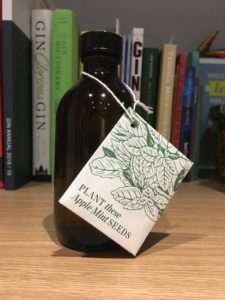
This approach fits with the Warner Edwards ethos, but also presented a challenge – if you can’t use citrus fruits, coriander seeds or angelica root, what do you put in your gin? Luckily within the three mile radius they have a plethora of goodies including lemon thyme, lemon verbena, lavender, chamomile leaves, bee pollen, dandelion root, toasted applewood and some homegrown green juniper (note: some juniper is also bought in from further away, but they understand that real gin actually tastes of juniper so needed to up the game slightly). Each bottle is preceded with a pack of seeds so you can grow your own apple mint garnish. My seeds seem to be struggling, but luckily I have a pregrown one to fall back on. So, how does it taste?
Wessex Alfred the Great Gin
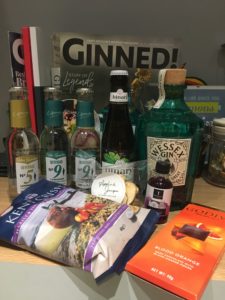 It’s September which means it is Craft Gin Club delivery time again! This month’s gin comes from Wessex Gin (along with a host of goodies including my fave cardamom tonic from Peter Spanton). Gin distilling is not a new venture for the founder of Wessex Gin, Jonathan Clark. Jonathan was the founder of the City of London Distillery (about 5 mins from my office, see my thoughts on the Six Bells gin and Square Mile gin) and when retirement didn’t suit him, he and his family decided to start all over again. The City of London Distillery is so ingrained in London, and when Jonathan and wife Gill moved to Wessex, they wanted that same connection to their surroundings. Having grown up in the countryside of Hampshire, we visited many a Roman/Saxon/Tudor sites thanks to school trips, and it’s this Anglo-Saxon time that inspired this gin. Specifically, the stories of King Alfred the Great, the man that scared off the Vikings (which was no mean feat). This era embraced the magic and the mystic, herbs were used for their healing properties and this has never really faded in the gin industry with a strong focus on the roots of their botanicals. The Anglo-Saxons were big on herbariums – a book listing herbs and their properties – and it is this that the Clark’s used to source their botanicals. Keen to make a classic London Dry gin which is heavy on the juniper, Jonathan also favours citrus led gins, with a hint of coriander and medicinal chervil, nowadays bringing an aniseed quality but also reportedly soothing stomach ailments – did you know King Alfred suffered from stomach problems with people thinking it was akin to Crohn’s Disease. So, how does it taste?
It’s September which means it is Craft Gin Club delivery time again! This month’s gin comes from Wessex Gin (along with a host of goodies including my fave cardamom tonic from Peter Spanton). Gin distilling is not a new venture for the founder of Wessex Gin, Jonathan Clark. Jonathan was the founder of the City of London Distillery (about 5 mins from my office, see my thoughts on the Six Bells gin and Square Mile gin) and when retirement didn’t suit him, he and his family decided to start all over again. The City of London Distillery is so ingrained in London, and when Jonathan and wife Gill moved to Wessex, they wanted that same connection to their surroundings. Having grown up in the countryside of Hampshire, we visited many a Roman/Saxon/Tudor sites thanks to school trips, and it’s this Anglo-Saxon time that inspired this gin. Specifically, the stories of King Alfred the Great, the man that scared off the Vikings (which was no mean feat). This era embraced the magic and the mystic, herbs were used for their healing properties and this has never really faded in the gin industry with a strong focus on the roots of their botanicals. The Anglo-Saxons were big on herbariums – a book listing herbs and their properties – and it is this that the Clark’s used to source their botanicals. Keen to make a classic London Dry gin which is heavy on the juniper, Jonathan also favours citrus led gins, with a hint of coriander and medicinal chervil, nowadays bringing an aniseed quality but also reportedly soothing stomach ailments – did you know King Alfred suffered from stomach problems with people thinking it was akin to Crohn’s Disease. So, how does it taste?
City of London Distillery Square Mile gin
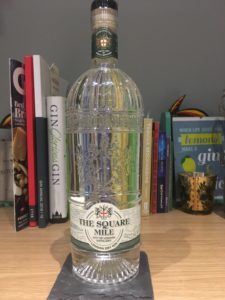 A few weeks ago, I went to the City of London Distillery for one of their distillery tours (which I recommend, it was great fun on a Wednesday night [note: I paid for this myself, it wasn’t gifted]). As we left, obviously I bought myself a bottle of gin. The City of London Distillery opened in 2012 on Bride Lane (literally five minutes from my office) with their traditional London Dry gin which was quickly followed by the Square Mile gin that I am trying today. Since then, they have also launched a Sloe gin, an Old Tom gin, their Christopher Wren gin, and a number of flavoured gin such as the Six Bells gin they launched with Craft Gin Club. The Square Mile gin is distilled with juniper, coriander seeds, fresh orange and lemon amongst others and won a Double Gold Award at the San Francisco World Spirits Competition in 2017 which is a pretty big deal. Bottled at 47.3% ABV, it is also the strongest gin they make (I am slightly surprised they haven’t added a navy strength gin to their family, but hey, there’s still time).
A few weeks ago, I went to the City of London Distillery for one of their distillery tours (which I recommend, it was great fun on a Wednesday night [note: I paid for this myself, it wasn’t gifted]). As we left, obviously I bought myself a bottle of gin. The City of London Distillery opened in 2012 on Bride Lane (literally five minutes from my office) with their traditional London Dry gin which was quickly followed by the Square Mile gin that I am trying today. Since then, they have also launched a Sloe gin, an Old Tom gin, their Christopher Wren gin, and a number of flavoured gin such as the Six Bells gin they launched with Craft Gin Club. The Square Mile gin is distilled with juniper, coriander seeds, fresh orange and lemon amongst others and won a Double Gold Award at the San Francisco World Spirits Competition in 2017 which is a pretty big deal. Bottled at 47.3% ABV, it is also the strongest gin they make (I am slightly surprised they haven’t added a navy strength gin to their family, but hey, there’s still time).
Opera Gin
Note: I met the team from Opera gin at Junipalooza and they kindly gave me a sample to try, as always I’ll let you know what I really think.
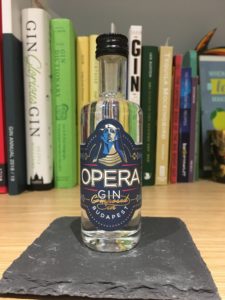 What is Opera gin?
What is Opera gin?
To anyone looking for their next holiday destination, I would recommend Budapest. It’s a lovely city and we had a very fun week there despite falling down the stairs in a ruin pub and spraining my ankle, and falling in the Danube (sprained ankle first). You might wonder why I’m telling you this, but today’s gin comes from that fine city. Fellow WSET student, Balint Damosy (also a lawyer) realised during his training that gin was his passion and spent two years researching and learning about gin, before deciding that launching their own gin was not as insane as they thought. And so Opera gin was born. In April 2018, they received their distilling license to become the first micro-distillery in Hungary, and set up shop in a former cotton factory within the Budapest city walls. They chose to create a traditional London Dry gin as they wanted to create something that was not just high quality, but also true to the spirit. They start with a Hungarian corn spirit before adding standard botanicals: hand picked juniper from the Kiskunság National Park; Bulgarian coriander seeds; angelica; orris root; and liquorice. They then make their gin unique by using citronella grass (which I’ve never come across as a botanical before but feel free to correct me!), lavender, a touch of aniseed and cubeb pepper, and their signature botanical poppy seed. They say this all blends together for a citrus and juniper forward gin that works well with tonic, but also pairs with a dry vermouth to make a crisp martini. So, how does it taste?
Gwyr Rhosili gin
Note: The lovely team at Gwyr gin sent me a bottle to try, but as always I will let you know what I really think.
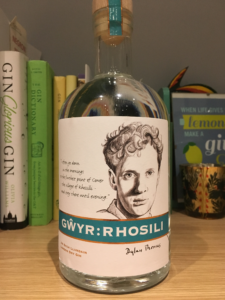 What is Gwyr Rhosili gin?
What is Gwyr Rhosili gin?
If you want to know about Gwyr gin, then I will point you to my posts on their original gin and their Pinwydd edition. Today, however, we are drinking their newest edition to the family, the Rhosili gin. This has been designed with the Dylan Thomas Estate to commemorate the poet’s links with Gower and Rhosili (his body is interred around the coastline in Laugharne). Thomas is most famous for poems such as Do not go gentle into that good night, a poem that has been quoted in numerous shows and films like Doctor Who and Independence Day. So how is this gin different to their others? Where their original gin focuses on pink grapefruit and fennel, the Rhosili edition features foraged gorse flowers, fresh lime zest, sea buckthorn (a botanical that seems to be appearing more and more) and linden flowers. Linden flowers have been used by herbalists for all sorts of things – coughs, colds, high blood pressure and migraines and research has shown that the flowers may have properties that help prevent damage to your liver. Which surely can only be a good thing when added to something that is proven to damage your liver? Please note I am not saying that drinking this is good for you in any way, as always, please drink responsibly. So, moving on, how does it taste?
Whitby Gin
Note: The team at Whitby gin kindly sent me a sample to try, but I will always let you know what I think
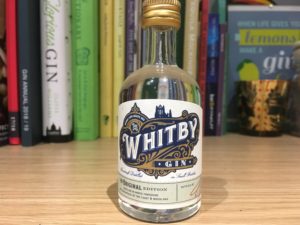 What is Whitby Gin?
What is Whitby Gin?
When I think of Whitby, I always think of Dracula, but it turns out the seaside town in North Yorkshire has more going for it than the place the Count landed in England. When Jess and Luke went on a camping trip to the Outer Hebrides in 2017, they were inspired by the amount of distilleries the islands housed, and Jess wondered why her hometown didn’t have one. Luckily, Jess has a background in business planning, and Luke one in food manufacturing, so they had a bit of a head start on the process. They ordered a still before they even got home and decided on three key botanicals: heather (sustainably sourced from the North York Moors), sugar kelp (from Robin Hood Bay) and honey (bought raw from their local bee keeper). 45 trials later and they had found the perfect combination of botanicals to complement these, including juniper, coriander seed, citrus peels and liquorice root and so Whitby Gin was born. These are added to their copper column stills (Stanley, Stockwell and Scripps, obviously) with their grain spirit and distilled once before hand bottling and labelling their products. Since their launch, they have won a host of awards including winning the Best London Dry Gin (UK) at the 2019 World Gin Awards.